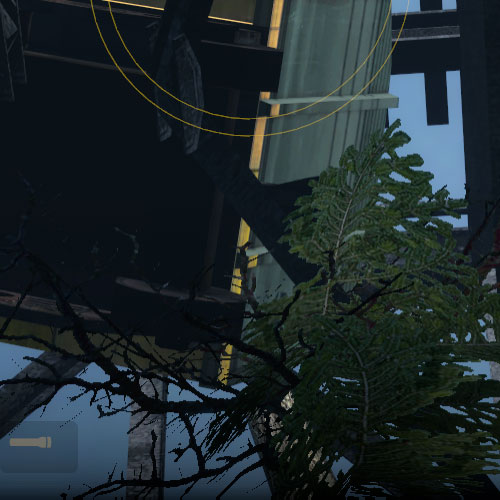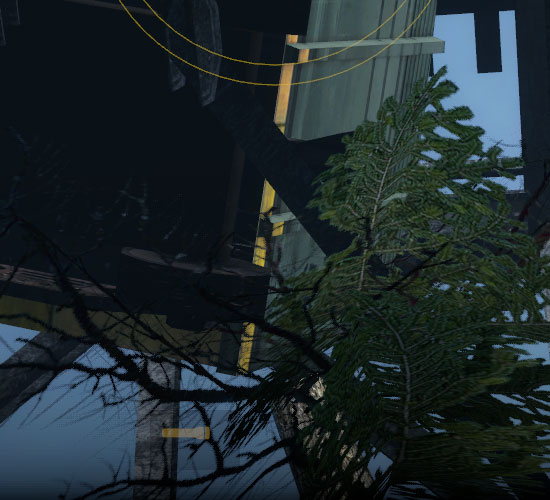AMD's Radeon HD 5870: Bringing About the Next Generation Of GPUs
by Ryan Smith on September 23, 2009 9:00 AM EST- Posted in
- GPUs
The Return of Supersample AA
Over the years, the methods used to implement anti-aliasing on video cards have bounced back and forth. The earliest generation of cards such as the 3Dfx Voodoo 4/5 and ATI and NVIDIA’s DirectX 7 parts implemented supersampling, which involved rendering a scene at a higher resolution and scaling it down for display. Using supersampling did a great job of removing aliasing while also slightly improving the overall quality of the image due to the fact that it was sampled at a higher resolution.
But supersampling was expensive, particularly on those early cards. So the next generation implemented multisampling, which instead of rendering a scene at a higher resolution, rendered it at the desired resolution and then sampled polygon edges to find and remove aliasing. The overall quality wasn’t quite as good as supersampling, but it was much faster, with that gap increasing as MSAA implementations became more refined.
Lately we have seen a slow bounce back to the other direction, as MSAA’s imperfections became more noticeable and in need of correction. Here supersampling saw a limited reintroduction, with AMD and NVIDIA using it on certain parts of a frame as part of their Adaptive Anti-Aliasing(AAA) and Supersample Transparency Anti-Aliasing(SSTr) schemes respectively. Here SSAA would be used to smooth out semi-transparent textures, where the textures themselves were the aliasing artifact and MSAA could not work on them since they were not a polygon. This still didn’t completely resolve MSAA’s shortcomings compared to SSAA, but it solved the transparent texture problem. With these technologies the difference between MSAA and SSAA were reduced to MSAA being unable to anti-alias shader output, and MSAA not having the advantages of sampling textures at a higher resolution.
With the 5800 series, things have finally come full circle for AMD. Based upon their SSAA implementation for Adaptive Anti-Aliasing, they have re-implemented SSAA as a full screen anti-aliasing mode. Now gamers can once again access the higher quality anti-aliasing offered by a pure SSAA mode, instead of being limited to the best of what MSAA + AAA could do.
Ultimately the inclusion of this feature on the 5870 comes down to two matters: the card has lots and lots of processing power to throw around, and shader aliasing was the last obstacle that MSAA + AAA could not solve. With the reintroduction of SSAA, AMD is not dropping or downplaying their existing MSAA modes; rather it’s offered as another option, particularly one geared towards use on older games.
“Older games” is an important keyword here, as there is a catch to AMD’s SSAA implementation: It only works under OpenGL and DirectX9. As we found out in our testing and after much head-scratching, it does not work on DX10 or DX11 games. Attempting to utilize it there will result in the game switching to MSAA.
When we asked AMD about this, they cited the fact that DX10 and later give developers much greater control over anti-aliasing patterns, and that using SSAA with these controls may create incompatibility problems. Furthermore the games that can best run with SSAA enabled from a performance standpoint are older titles, making the use of SSAA a more reasonable choice with older games as opposed to newer games. We’re told that AMD will “continue to investigate” implementing a proper version of SSAA for DX10+, but it’s not something we’re expecting any time soon.
Unfortunately, in our testing of AMD’s SSAA mode, there are clearly a few kinks to work out. Our first AA image quality test was going to be the railroad bridge at the beginning of Half Life 2: Episode 2. That scene is full of aliased metal bars, cars, and trees. However as we’re going to lay out in this screenshot, while AMD’s SSAA mode eliminated the aliasing, it also gave the entire image a smooth makeover – too smooth. SSAA isn’t supposed to blur things, it’s only supposed to make things smoother by removing all aliasing in geometry, shaders, and textures alike.
As it turns out this is a freshly discovered bug in their SSAA implementation that affects newer Source-engine games. Presumably we’d see something similar in the rest of The Orange Box, and possibly other HL2 games. This is an unfortunate engine to have a bug in, since Source-engine games tend to be heavily CPU limited anyhow, making them perfect candidates for SSAA. AMD is hoping to have a fix out for this bug soon.
“But wait!” you say. “Doesn’t NVIDIA have SSAA modes too? How would those do?” And indeed you would be right. While NVIDIA dropped official support for SSAA a number of years ago, it has remained as an unofficial feature that can be enabled in Direct3D games, using tools such as nHancer to set the AA mode.
Unfortunately NVIDIA’s SSAA mode isn’t even in the running here, and we’ll show you why.

5870 SSAA

GTX 280 MSAA

GTX 280 SSAA
At the top we have the view from DX9 FSAA Viewer of ATI’s 4x SSAA mode. Notice that it’s a rotated grid with 4 geometry samples (red) and 4 texture samples. Below that we have NVIDIA’s 4x MSAA mode, a rotated grid with 4 geometry samples and a single texture sample. Finally we have NVIDIA’s 4x SSAA mode, an ordered grid with 4 geometry samples and 4 texture samples. For reasons that we won’t get delve into, rotated grids are a better grid layout from a quality standpoint than ordered grids. This is why early implementations of AA using ordered grids were dropped for rotated grids, and is why no one uses ordered grids these days for MSAA.
Furthermore, when actually using NVIDIA's SSAA mode, we ran into some definite quality issues with HL2: Ep2. We're not sure if these are related to the use of an ordered grid or not, but it's a possibility we can't ignore.
If you compare the two shots, with MSAA 4x the scene is almost perfectly anti-aliased, except for some trouble along the bottom/side edge of the railcar. If we switch to SSAA 4x that aliasing is solved, but we have a new problem: all of a sudden a number of fine tree branches have gone missing. While MSAA properly anti-aliased them, SSAA anti-aliased them right out of existence.
For this reason we will not be taking a look at NVIDIA’s SSAA modes. Besides the fact that they’re unofficial in the first place, the use of a rotated grid and the problems in HL2 cement the fact that they’re not suitable for general use.












327 Comments
View All Comments
SiliconDoc - Sunday, September 27, 2009 - link
I'll be watching you for the very same conclusion when NVidia launches soft and paper.I'll bet ten thousand bucks you don't say it.
I'll bet a duplicate amount you're a red rager fan, otherwise YOU'D BE HONEST, NOT HOSTILE !
rennya - Thursday, September 24, 2009 - link
It may be paper-launch in the US, but here somewhere in South East Asia I can already grab a Powercolor 5870 1GB if I so desire. Powercolor is quite aggresive here promoting their ATI 5xxx wares just like Sapphire does when the 4xxx series comes out.SiliconDoc - Thursday, September 24, 2009 - link
I believe you. I've also seen various flavors of cards not available here in the USA, banned by the import export deals and global market and manufacturer and vendor controls and the powers that be, and it doesn't surprise me when it goes the other way.Congratulations on actually having a non fake launch.
Spoelie - Wednesday, September 23, 2009 - link
"The engine allows for complete hardware offload of all H.264, MPEG-2 and VC1 decoding".This has afaik never been true for any previous card of ATi, and I doubt it has been tested to be true this time as well.
I have detailed this problem several times before in the comment section and never got a reply, so I'll summarize: ATi's UVD only decodes level 4 AVC (i.e. bluray) streams, if you have a stream with >4 reference frames, you're out of luck. NVIDIA does not have this limitation.
lopri - Wednesday, September 23, 2009 - link
Yeah and my GTX 280 has to run full throttle (3D frequency) just to play a 720p content and temp climbs the same as if it were a 3D game. Yeah it can decode some *underground* clips from Japan, big deal. Oh and it does that for only H.264. No VC-1 love there. I am sure you'd think that is not a big deal, but the same applies to those funky clips with 13+ reference frames. Not a big deal. Especially when AMD can decode all 3 major codecs effortlessly (performance 2D frequency instead of 3D frequency)rennya - Thursday, September 24, 2009 - link
G98 GPUs (like 8400GS discrete or 9400 chipset) or GT220/G210 can also do MPEG2/VC-1/AVC video decoding.The GPU doesn't have to run full throttle either, as long as you stick to the 18x.xx drivers.
SJD - Wednesday, September 23, 2009 - link
Ryan,Great article, but there is an inconsistancy. You say that thanks to there only being 2 TDMS controllers, you can't use both DVI connectors at the same time as the HDMI output for three displays, but then go onto say later that you can use the DVI(x2), DP and HDMI in any combination to drive 3 displays. Which is correct?
Also, can you play HDCP protected content (a Blu-Ray disc for example) over a panel connected to a Display Port connector?
Otherwise, thanks for the review!
Ryan Smith - Wednesday, September 23, 2009 - link
It's the former that is correct: you can only drive two TDMS devices. The article has been corrected.And DP supports HDCP, so yes, protected content will play over DP.
SJD - Friday, September 25, 2009 - link
Thanks for clarifying that Ryan - It confirms what I thought.. :-)chowmanga - Wednesday, September 23, 2009 - link
I'd like to see a benchmark using an amd cpu. I think it was the Athlon II 620 article that pointed out how Nvidia hardware ran better on AMD cpus and AMD/ATI cards ran better on Intel cpus. It would be interesting to see if the 5870 stacks up against Nv's current gen with other setups.